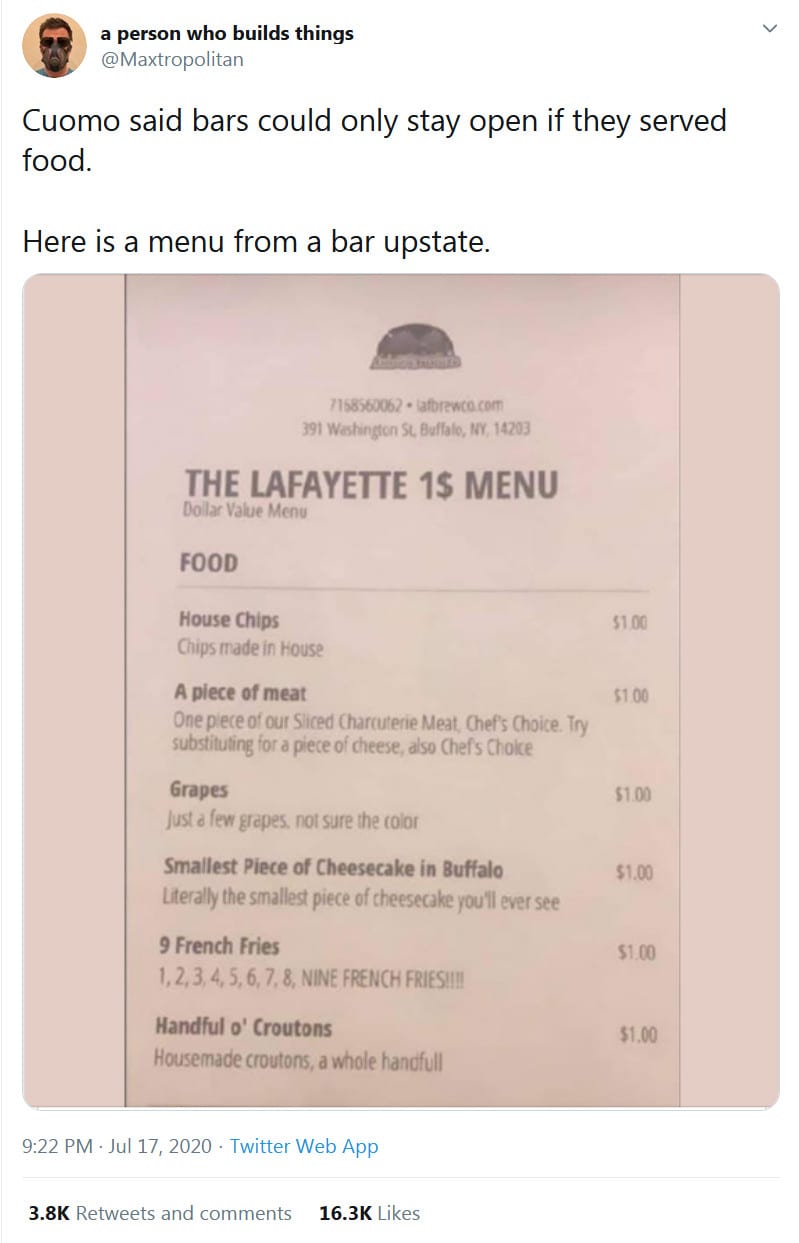Archive for 2020
July 19, 2020
WARD FARNSWORTH: What Did Lincoln Know About Language That We Don’t?
A TALE OF TWO SWAMPS:
Shot: Pompeo denounces ‘Marxist’ 1619 Project as gift to Chinese Communist Party.
—The Washington Examiner, Thursday.
Chaser: Top Intelligence Official Promoted ‘White Fragility’ Recommendation.
—The Epoch Times, Tuesday.
WHY ARE DEMOCRAT-MONOPOLY REGIONS SUCH CESSPITS OF VIOLENCE AND RACISM? Homicides Up 14% in SF Bay Area: Vallejo Council Member Blames ‘Systemic Racism.’
IS ANYONE THESE DAYS NOT A LIMITED-PURPOSE PUBLIC FIGURE? I may lose my First Amendment lawyer card for this, but Glenn’s earlier post about the Joy Reid lawsuit brings up a huge problem with libel law in the Internet age: the famous person you sue for libeling you on Twitter is effectively the one who makes you a public figure, and therefore gets to make winning a suit against them almost impossible (at least, if you can’t afford a hugely expensive trip to federal appeals court, and maybe not then). If people think a free press means the press gets to destroy random Americans with impunity, why wouldn’t they stop supporting it?
Update: I managed to confuse people here. The district court found that she was a limited purpose public figure; this article was about the Second Circuit reversing that finding, hence my comment about the expensive trip to appeals court. Sorry I was not clearer!
21st CENTURY HEADLINES: No MILFs, No Squirting, No Gang Bangs: How the Porn Industry Is Changing During COVID-19.
SO GIVEN A CHOICE, I’D TEACH AS NORMAL IN THE FALL. But forced to choose between our lame partly online / partly in-class “hybrid” approach and online teaching I’ve chosen online. I managed to make it work tolerably well — it was C-SPAN-worthy! — last semester, and I was extemporizing. I’ve been working on making it better over the summer. Some of that is assignment changes, but I’m also going to a multi-camera setup. I’m moving from my study to what we call the “poolhouse,” though it isn’t really one, but rather a Tiny House, essentially a fancy shed, that a previous owner built for writing and yoga. It has great lighting and its own heat and AC. I’m going to use my Nikon DSLR as a lectern camera, and two small Sony video cameras with it, one focused on a whiteboard and the other a wide camera so I can move around. The superb law school IT guy got me this little switcher that looks like a webcam to Zoom, but lets me switch between the cameras with a touch. (The only thing that would be better is if it had a pocket remote). I hope that will make things a bit more visually interesting.
THANK GOODNESS, I’VE GOTTEN SO TIRED OF COUNTING THEM ONE BY ONE: Scientists find faster way to count animal sperm using DNA.
MOSTLY PEACEFUL SEDITION: Portland Protest Organizer Says Her Goal Is the Abolition of America ‘As We Know It’ (Video).
ON THE ROCKS: More Than Just a Fire: The Implications of the Bonhomme Richard Catastrophe.
In the U.S. Navy, “shock trials” involve taking a warship to sea and conducting drills to see how well she might absorb the stress of combat. The Navy has lately experienced institutional shock trials: bribery scandals, collisions and sundry other public-relations nightmares. This week in San Diego the USS Bonhomme Richard, a $750 million amphibious assault ship, caught fire and burned for days. Earlier this year, Capt. Brett Crozier was relieved of command of the USS Theodore Roosevelt after writing a letter saying he needed to move his sailors off the aircraft carrier to arrest an outbreak of the novel coronavirus.
High-profile mishaps and unwanted publicity point to an overarching problem: For several years the Navy has been forced to do too much with too little, a debate that deserves wider attention. The Navy also seems to be suffering from a cultural dysfunction in the chain of command. To repair it, the Navy will need to reinvent its process for refining leaders and perhaps even the service’s broader mission. What’s at stake is the quality of American military talent that fights the next war—an eventuality that seems less far-fetched amid the tense mood of a global pandemic.
The 2017 crashes in the Western Pacific involving the USS John S. McCain and USS Fitzgerald still loom large in the Navy. An investigation revealed that Pacific fleet ships were going to sea with too little training and that crews weren’t skilled in the basics of sea navigation. Also implicated was the Navy’s “can do” culture—the propensity of naval officers to try to get the job done no matter the cost.
“Interviews revealed that, particularly among ships based in Japan, crews perceived their Commanding Officer was unable to say ‘no’ regardless of unit-level consequence,” according to a 177-page “comprehensive review” of the 2017 incidents. Vice Adm. Joseph Aucoin, who commanded the Seventh Fleet during the collisions, wrote in a naval publication that he’d “made clear” to his superiors “the impact of increased operational demand on training and maintenance well prior” to the accidents. Despite “explicitly stated concerns,” he wrote, “the direction we received was to execute the mission.” He was fired shortly after the accidents.
In 2015, a submarine ran aground in Florida, resulting in $1 million in damage. The Navy fired Capt. David Adams, the officer in command when the accident occurred. Journalist Hope Hodge Seck of Military.com made a public-records request for the 475-page investigation, the details of which she published in March. Capt. Adams had warned his superiors that his crew was too inexperienced to handle a precarious predawn return to port. He was nevertheless told to execute the mission.
The Navy’s tradition of firing commanding officers who fail is a venerable one, and the Navy has tried to absorb the lessons of these incidents. But as Ms. Seck notes, the sub mishap “came against the backdrop of a Navy grappling with a culture in which overworked and unready crews were regularly put underway in service of operational needs.” The careers of commanders like Capt. Adams can look like the casualties.
The Roosevelt is a confounding example. The Navy’s investigation makes a strong case for removing Capt. Crozier. He failed to rein in the ship’s senior medical officer, who, according to the Navy’s investigation, was predicting up to 50 virus deaths on the ship and threatening to take the medical department’s grim case to the press. (One sailor assigned to the Roosevelt died from complications of Covid-19.)
Yet the Navy’s report also details how the Roosevelt’s leadership became frustrated with its superiors at Seventh Fleet headquarters over the chaotic process of moving sailors off the ship.
On the upside, everyone’s diversity and trans-awareness training is up to date.
THE ODDS ARE 1/1024 IN HER FAVOR: Can Elizabeth Warren be vice president in the age of Black Lives Matter?
I REMEMBER WHEN THE DEMS PITCHED CONOR LAMB AS A NORMAL, MODERATE CANDIDATE: DISGUSTING: Conor Lamb’s brother and campaign manager called OUT for wishing death on opponent Sean Parnell.
THE ONLY GOOD THING ABOUT THIS PROGRAM IS THAT THEY DIDN’T TRY TO BUILD MORE: US Navy scuppers flawed Littoral Combat Ship fleet: Italian-French designed FREMM frigate with possible DART missile system will replace the much maligned LCS.
BASED ON THE GRAY LADY’S OWN “LOGIC,” IT NEEDS TO CANCEL ITSELF: The family that owns The New York Times were slaveholders.
And that name “New York” is pretty racist in and of itself: The True Native New Yorkers Can Never Truly Reclaim Their Homeland.
Related: Ancestors of Senate Dem. Who Backs ‘1619 Project’ Allegedly Harbored John Wilkes Booth.
NY PUB OFFERS ‘CUOMO CHIPS’ TO COMPLY WITH NEW CORONAVIRUS RULE ON FOOD, BOOZE:
“I mean why not, they’re his chips, they’re his rule so he might as well get some recognition and acknowledgment for another little hurdle we have to jump through as business owners,” [Saratoga NY’s Harvey’s Irish Pub Owner Matthew Bagely ] told the station, referring to the governor.
A photo of a tab shows a bag of Cuomo Chips will set you back one dollar plus sales tax–a portion of which goes to New York State coffers.
Cuomo senior adviser Rich Azzopardi said Friday that the Harvey’s chips don’t violate the governor’s food-requirement rule, according to the New York Post.
“It’s consistent with the guidance — but you have to be seated,” Azzopardi said.
And they’re apparently far from the only New York State bar serving $1.00 chips:

(Note though, that the Lafayette Brewing Company and Harvey’s Irish Pub offer more upscale dining choices as well.)
THIS SUGGESTS THAT WAYNE STATE REGARDS THE BAR EXAMINERS AS LAWLESS AND VINDICTIVE, WHICH ARGUES FOR THE ABOLITION OF THE BAR EXAMINERS: Law school warns students not to advocate dropping bar exam on social media. “The email from the law school stated ‘while you have every right to criticize the bar exam, the Board of Law Examiners, or the State Bar of Michigan online, it may not be a smart strategy for passing Character & Fitness with ease.'”

